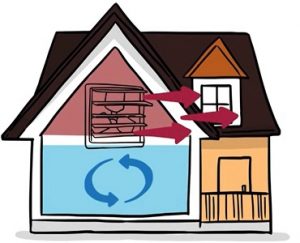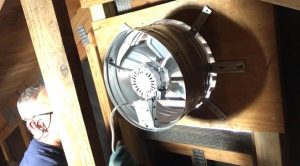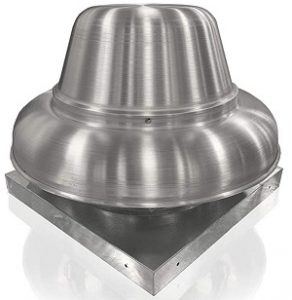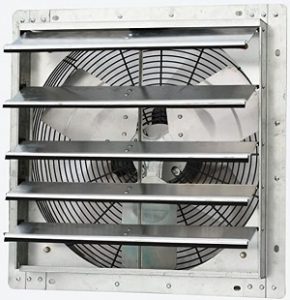Attic spaces can be very hot especially during the hot sunny days. Installing an attic exhaust fan will help lower the temperature in the attic space. It does this by drawing in the cool air from outside and letting out the warm air. A fan that is proportional to the attic space should be installed to achieve the right cooling effect.
If your attic is poorly insulated or sealed, you will need to redo the work to avoid heat and moist air leakage that might damage the attic. An attic fan can be installed on the roof or the wall of a house. Where to install your fan will be influenced by the cost involved in doing the work. If you are to redo all work in the attic, it will be costly and your attic might not be accessible. Attic exhaust fan installation can be convenient and you can join the fan with the existing vent.

Should I Install An Attic Exhaust Fan?
The attic usually becomes very hot because of the accumulation of heat. Installing a fan will help reduce the temperatures in the attic region and, therefore, reduce the temperature of the whole house.
It is not a must that you install an attic fan because they tend to cause more problems than they can solve. A powerful attic exhaust fan might cause loss of conditioned air. The powerful attic fan will suction conditioned air through some unsealed spaces and dump it outside. This will increase the load on your air conditioning unit that increases the cost of electricity.
Alternatively, an attic fan can be a suitable fixture in your home. If your home’s attic space is fully sealed, you will need an attic fan. The attic fan will stabilize the temperature in the attic and let you create a comfortable relaxing environment.
You might also need an attic exhaust fan installed if you have large soffit ventilation in your home. The soffit ventilation will let in much cool air that may reduce the temperature significantly. An attic fan will remove the warm rising air and stabilize the house temperature.
Best Selling – Cool Attic CX1500 Gable-Mounted Exhaust Fan
- Ventilator Fan: This is a 1300 CFM Power Attic Gable Mount Ventilator with a 2. 6 Amp thermally protected motor, a galvanized steel flange, and an automatic thermostat
- Gable Mount Fan: It mounts easily in the gable of your home, behind existing louvers or any other gable louvers of your choice. It will provide ventilation without modifying your roofline, or where roof-mounting is impractical. It mounts easily in gable behind louvers
- Attic Fan: The Cool Attic Gable-Mount Attic Ventilator Fan offers effective power attic ventilation to reduce heat buildup, equalize temperatures inside and outside the attic. It has 14-inch fan with 600-square-inch intake. It is galvanized steel construction
- Easy Installation: It cools attic up to 1, 850 square feet and 3. 4-amp, 115-volt, 60-Hz thermally protected motor, 1, 300 CFM rating at 0. 03 static pressure when used with model No. CX2121 automatic shutter. It helps keep your home cooler and reduce utility costs
- Home Roof Cooling Fan: This fan helps prevent weather-induced home deterioration and make living areas more comfortable - all while helping reduce the operating cost of air conditioning. Easy to install with no holes in roof
Attic Exhaust Fan Installation Guide
In installing an attic exhaust fan, you can use an existing roof or a vent. This will save you the trouble involved in opening up new holes and having trouble fixing them.
1. Decide Where to Put the Fan
Some fans are fixed on the roof and those fixed on the wall. The fans fixed on the roof require a lot of labor and are costly compared to those fixed on the wall. Depending on your preference, you will choose the one you see it is perfect for your home.
After choosing the fan, you will have to select the location in your home so that the fan is installed close to the house’s center. Have it near the roof edge to not be seen from the front of your home.
2. Do Some Measurements
You will now measure the distance between the location of the vent and the edge of the roof. After measuring transfer the measurements to the attic. Mark a location inside the attic that should be equal distance between the rafters and drill a hole through the roof using the marked point as the center.
3. Put the Circle Template in Place
Take the circle template from the box and place it on the roof using the hole as the center. Trace around the circle on the shingles and cut through the marked circle. After drilling, you can remove the vents dome from the fan, this will make installation easier.
4. Place the Fan in the Center
Place the fan over the hole and make sure it is placed in the center. You should ensure the flange is pointing towards the ridge but under the shingles. When the fan is in place, you can seal the space between the roof and the fan.
Using a knife cut the shingles at the top to fix the fan’s throat. This will ensure you have your attic fan ready to use.
>> Click here to watch How to Install Gable-Mounted Attic Exhaust Fans.
Where Should Attic Fans Be Placed?
An attic fan can be installed on the ceiling or the wall. Depending on the attic condition, you have to be careful when selecting a place to install a fan. Sometimes you may have a fully sealed attic that will need you to redo a lot of work to install the attic fan. You will need to open the ceiling and cut through the roof to install some fixtures. This becomes very expensive.
If you have a ceiling and HVAC equipment installed during construction, it will be an easy task to place a whole house attic fan. If you cannot access your ceiling redoing, some work can be costly and the fan can be installed on the wall. Setting the attic exhaust fan on the wall and attaching it to an existing vent can be cheap. You should consider the work to be done and the cost involved before deciding on the location to place the fan.
How Much Does It Cost to Install An Attic Fan?
There are different types of attic fans that are powered by electricity or solar power. Depending on the location you will install the fan their cost will differ. Attic fans mounted on the roof will cost more than those installed on the walls. For installation in the roof, you will have to open the roof, and to fix them may require additional labor making it costly.
Another factor is the labor cost which differs among companies. You may need a roofer to open and seal the roof, an electrician to connect the fan, and a carpenter to open up the attic. This will make the cost of installation vary among homes. Most people will spend between 300 dollars and 600 dollars to have an attic fan installed.
Does An Attic Fan Use A Lot of Electricity?
No, an average attic ventilation fan uses 300 watts of electricity, making it energy efficient. Some people, however, argue that it saves money but it is not an energy-saving fixture. Georgia has banned the use of electric attic fans because they are deemed not to be energy saving.
Best Energy-Efficient – iPower 12″ Attic Exhaust Fan, Easy Installation
- APPLICATIONS This 12 inch shutter/exhaust fan with automatic Shutters can help replace your ac unit by cooling your garage attic greenhouse shop or chicken coop Can easily be added to a window opening or opening in the wall along with a Speed Controller to optimize cooling
- Shutter Exhaust Fan 120Volts 60W 0.5A 1620RPM 940CFM
- Fan Speed Controller iPower Fan Speed Controller will correctly and precisely adjust the speed of your Shutter Exhaust Fan Durable 3-Pole Grounded Plug Construction No Extra Wires to Deal With
- Multiple Speed One control switch for 3 Variable Speed settings OFF HIGH MED LOW
- Power Cord Kit This Power Cord Kit is easy to install & includes a 3-foot strain relief clamp wire connectors & installation instructions Simplify installation of your Ventilation Fan with this easy to use power cord kit Universal extension cord power kit works. PoRible
Conclusion
Installing an attic exhaust fan requires many skills so that you do not damage your whole structure. It can be costly when there are no HVAC pieces of equipment since you will be doing a lot of work. Installation should be easy if you have the right tools and you know how to fix it.
Our Top 3 Picks for Best-Quality Attic Exhaust Fan







